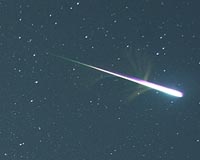|
|
|
Meteorite Hoax In Northern Latvia, Many Tricked Riga, Latvia (RIA Novosti) Oct 26, 2009  No one was injured after a meteorite fell near a small town in northern Latvia on Sunday, local Latvian media reported. According to media reports, the meteorite fell near a residential house on the outskirts of Mazsalaca town in the Valmiera district of Latvia, leaving a crater of some 20 meters (66 feet) in diameter and 10 meters (33 feet) deep. A spokesperson for the Latvian State Fire ... read more
No one was injured after a meteorite fell near a small town in northern Latvia on Sunday, local Latvian media reported. According to media reports, the meteorite fell near a residential house on the outskirts of Mazsalaca town in the Valmiera district of Latvia, leaving a crater of some 20 meters (66 feet) in diameter and 10 meters (33 feet) deep. A spokesperson for the Latvian State Fire ... read moreMESSENGER Gets Closest Look At Solar-Flare Neutrons  Tempe AZ (SPX) Oct 27, 2009
Tempe AZ (SPX) Oct 27, 2009On Dec. 31, 2007, the Sun awoke from the relatively quiescent period between Solar Cycles 23 and 24 to produce a solar flare that spewed high-energy neutrons into interplanetary space. The Neutron Spectrometer flying aboard NASA's MESSENGER spacecraft recorded the event, giving scientists a first-ever, up-close look at neutron production from a solar flare. In fact, it was the first time ... more
|
Vietnam says parched Red River at record low
China to be world's third biggest wind power producer: media Cost-cutting NASA eyes three cheap space missions Honduras declares state of emergency amid drought Russia in secret plan to save Earth from asteroid: official Sarkozy scrambles to salvage carbon tax French carbon tax ruled illegal Brazil's Lula signs law cutting CO2 emissions 2009 a 'benign' year of natural disasters: German re-insurer Greenpeace Spain demands Denmark release its director
| |||||||||||||||
| Previous Issues | Oct 26 | Oct 23 | Oct 22 | Oct 21 | Oct 20 |
| . |
Astronomy Question Of The Week: What Happens When Stars Play Hide-And-Seek Bonn, Germany (SPX) Oct 27, 2009
Bonn, Germany (SPX) Oct 27, 2009Astronomers know the answer and would therefore have been able to answer the One-Million-Euro question in the 250th episode of Gunter Jauch's hit TV show 'Wer wird Million�r?' (Who wants to be a millionaire?): What is an eclipsing binary? An eclipsing binary is a special binary star system. A binary star is a system comprising two stars which lie close to one another and which move around ... more Kangaroos On The Moon  Sydeny, Australia (SPX) Oct 27, 2009
Sydeny, Australia (SPX) Oct 27, 2009When Apollo astronauts landed on the Moon, they found it wasn't easy to walk around. The low gravity, uneven ground and bulky spacesuits hindered their movement. To move long distances quickly, the astronauts found it was easier to make small "kangaroo hops" with both legs. They would literally propel themselves above the surface before they made gentle falls to the ground. Machines that ... more Detecting Life-Friendly Moons  Moffett Field CA (SPX) Oct 27, 2009
Moffett Field CA (SPX) Oct 27, 2009Forty years ago, the Apollo astronauts traipsed across our Moon, making it "inhabited" for the first time - albeit for only two and half hours. A bona-fide habitable moon has never been found, but astronomers are considering how we might find one around distant stars. "I think exomoons are just as interesting as exoplanets," says David Kipping of University College London. In our own ... more |
. |
| . |
Sidewalk Astronomy To Span US During 'Galilean Nights' Washington DC (SPX) Oct 22, 2009
Washington DC (SPX) Oct 22, 2009Astronomy enthusiasts across the globe are breaking out their telescopes this weekend (October 22-24) in a coordinated effort to help hundreds of thousands of people experience their own "Galileo moment" of awe and discovery when seeing the planet Jupiter and its four largest moons. More than 800 public observing events in over 50 countries are being organized as part of "Galilean Nights," ... more Nobel Prize-Winning Science - Springboard For Planet Hunting  Boulder CO (SPX) Oct 22, 2009
Boulder CO (SPX) Oct 22, 2009The University of Colorado at Boulder and the National Institute of Standards and Technology have been awarded a $495,000 grant to look for Earth-like planets around other stars using technology based on 2005 Nobel Prize-winning research conducted at JILA, a joint institute of the two Boulder institutions. The funding from the National Science Foundation is to develop a precise "laser rule ... more Space Trash And The Great Debate  Bethesda MD (SPX) Oct 21, 2009
Bethesda MD (SPX) Oct 21, 2009Just last week the topic of Space Debris Removal made the "big league" conference circuit at the 60th International Astronautical Congress in Daejeon, Republic of Korea. In fact, in addition to several dedicated sessions on topics addressing almost every aspect of debris production phenomena, improved tracking accuracy, better conjunction prediction methods, advanced mitigation techniques ... more |
. |
| Previous Issues | Oct 26 | Oct 23 | Oct 22 | Oct 21 | Oct 20 |
| The contents herein, unless otherwise known to be public domain, are Copyright 1995-2009 - SpaceDaily. AFP and UPI Wire Stories are copyright Agence France-Presse and United Press International. ESA Portal Reports are copyright European Space Agency. All NASA sourced material is public domain. Additional copyrights may apply in whole or part to other bona fide parties. Advertising does not imply endorsement, agreement or approval of any opinions, statements or information provided by SpaceDaily on any web page published or hosted by SpaceDaily. Privacy statement |